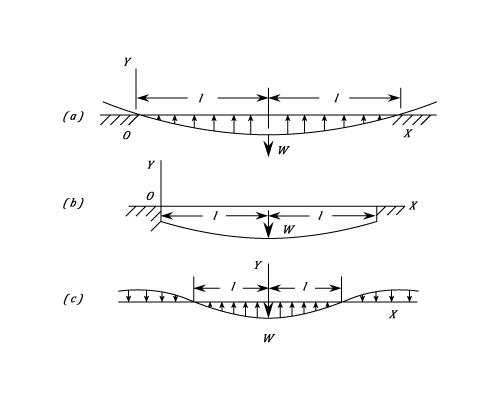Elastic Foundations
The deflection of beams where the foundations are not rigid.
Contents
Beams On Elastic Foundations.
There are many problems in which a beam is supported on a compressible foundation which exerts a distributive reaction on the Beam of intensity proportional to the compressibility. In some cases the foundations can only exert upward forces and the beam may, if it is sufficiently long, lose contact with the foundation. In other cases pressure may be exerted either way. Again the support may not be truly continuous( eg. the support of railway lines) but can be replaced by an equivalent distributed support. IfA beam is a horizontal structural element that is capable of withstanding load primarily by resisting bending. The bending force induced into the material of the beam as a result of the external loads, own weight, span and external reactions to these loads is called a bending moment.
(a) Long Beam Carrying A Central Load.
Elastic force is a force arising from the deformation of a solid body which depends only on the body's instantaneous deformation and not on its previous history, and which is conservative.
This example assumes that the foundations can only exert an upward force. The length of beam in contact with the foundations is  and the Origin
and the Origin  is at the left-hand end.
is at the left-hand end.
A solution to  can be written as:-
can be written as:-
 At
At  And
And  Also
Also  Giving:
Giving:
&space;+&space;C\;(-\sin0\times&space;\sinh0&space;+&space;\cos0\times\cosh0)]&space;=&space;0) Thus,
Thus,  The equation is now reduced to:
The equation is now reduced to:
) At
At 
 The least solution of this is
The least solution of this is  which determines the length in contact with the ground. The value of the constant
which determines the length in contact with the ground. The value of the constant  is obtained from the condition that the Shear Force at the centre is
is obtained from the condition that the Shear Force at the centre is  since by symmetry it must be numerically the same on either side of the load and it must change by an amount
since by symmetry it must be numerically the same on either side of the load and it must change by an amount  on passing through the load.
Hence,
on passing through the load.
Hence,
 Or
Or  The maximum Deflection and Bending Moment are at the centre,
The maximum Deflection and Bending Moment are at the centre, 
\;\coth\;\frac{\pi&space;}{2})
\;\coth\;\frac{\pi&space;}{2}&space;=&space;\left(\frac{W}{4\alpha&space;}&space;\right)\coth\;\frac{\pi&space;}{2})
Deflection is a term that is used to describe the degree to which a structural element is displaced under a load.
(b) Short Beam Carrying A Central Load W
IfAt  And
And  And
And
&space;+&space;D\cos\alpha&space;x\times\cosh\alpha&space;x) At
At 
&space;=&space;0) And
And  Thus
Thus
)
 Solving for
Solving for  and
and 
)
)
The complete solution for (c) An Infinite Beam Carrying A Load.
Assuming that the Support can exert pressure either upwards or downwards and taking theExample:
[imperial]
Example - Example 1
Problem
A steel railway track is supported on timber sleepers which exert an equivalent load of 400lb./in. length of rail per inch deflection from its unloaded position. For each rail  and
and  .
If a point load of 10 tons acts on each rail, find the length of rail over which the sleepers are depressed and the maximum Bending Stress in the rail.
.
If a point load of 10 tons acts on each rail, find the length of rail over which the sleepers are depressed and the maximum Bending Stress in the rail.
Workings
Solution
- The length is
- The maximum Bending Stress in the rail is
 Login
Login


